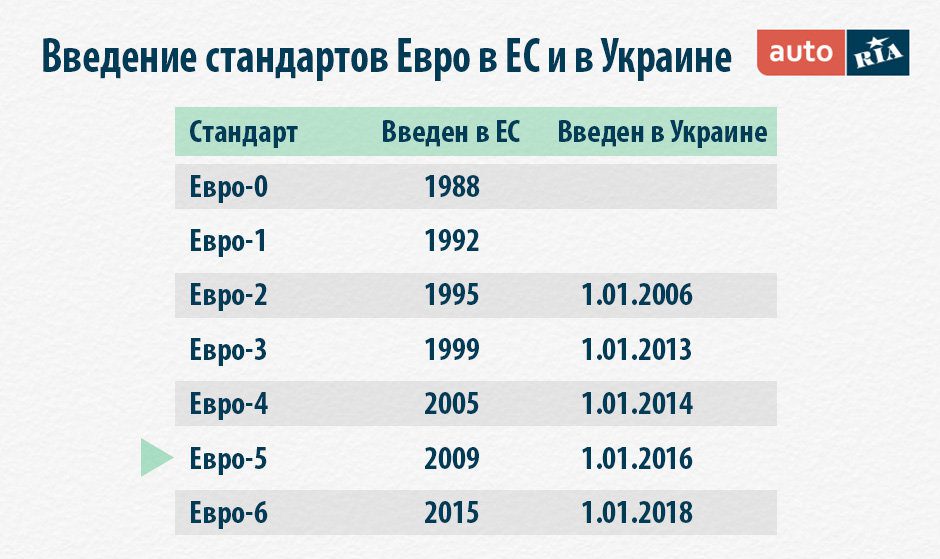
EURO - European Emission Standards
The European Emissions Standards are a set of rules and regulations that set limits on the composition of the exhaust gases of all vehicles produced in EU member states. These directives are called Euro emission standards (Euro 1 to Euro 6).
Each introduction of a new euro emission standard is a gradual action.
The changes will primarily affect models recently introduced to the European market (for example, the current Euro 5 standard was set for September 1, 9). Cars put on sale do not have to comply with the Euro 2009 standard. From year 5, Euro 2011 must comply with all new cars produced, including older models with catch-up production. Owners of already purchased old cars can remain alone, they are not subject to the new rules.
Each new EURO standard contains new rules and restrictions. The current EURO 5 emission standard, for example, has a greater impact on diesel engines and aims to bring them closer to gasoline emissions in terms of exhaust emissions. EURO 5 reduces the PM (Particulate Particulate Soot) emission limit by one fifth compared to the current state, which can practically only be achieved by installing particulate filters, which are not the cheapest. It was also necessary to use new technologies to reach the NO limits.2... In contrast, many gasoline engines already in production today comply with the new EURO 5 directive. In their case, it was only a 25% reduction in the limits for HC and NO.2, CO emissions remain unchanged. Every introduction of an emission standard meets with objections from car manufacturers due to increased production costs. For example, the introduction of the EURO 5 standard was originally planned for 2008, but due to pressure from the automotive industry, the introduction of this standard was postponed until September 1, 9.
How have these emission directives evolved?
Euro 1... The first directive was the EURO 1 directive, which has been in effect since 1993 and was relatively benevolent. For gasoline and diesel engines, it sets a limit for carbon monoxide of about 3 g / km and NO emissions.x and HC have been added. The particulate matter emission limit applies only to diesel engines. Gasoline engines must use unleaded fuel.
Euro 2. The EURO 2 standard already separated the two types of engines - diesel engines had a certain advantage in NO emissions.2 and HC, on the other hand, when the cap is applied to their sum, gasoline engines can afford higher CO emissions. This directive also showed a reduction in lead particulate matter in exhaust gases.
Euro 3... With the introduction of the EURO 3 standard, which has been in effect since 2000, the European Commission began to tighten. For diesel engines, it reduced PM by 50% and set a fixed limit for NO emissions.2 at 0,5 g / km. At the same time, he ordered a 36% reduction in CO emissions. This standard requires gasoline engines to meet stringent NO emissions requirements.2 and HC.
Euro 4... The EURO 4 standard, which came into force on October 1.10, 2006, further tightened the emission limits. Compared to the previous Euro 3 standard, it has halved particulate matter and nitrogen oxides in vehicle exhaust gases. In the case of diesel engines, this has forced manufacturers to significantly reduce CO, NO emissions.2, unburned hydrocarbons and particulates.
Euro 5... Since 1.9. The 2009 emission standard was mainly aimed at reducing the amount of PM foam parts to one fifth of the original amount (0,005 versus 0,025 g / km). The NOx values for gasoline (0,08 to 0,06 g / km) and diesel engines (0,25 to 0,18 g / km) also decreased slightly. In the case of diesel engines, a decrease in HC + NO content was also observed.X z 0,30 n.d. 0,23 g / km.
ЕВРО 6... This emission standard came into force in September 2014. It applies to diesel engines, namely the reduction of NOx values from 0,18 to 0,08 g / km and HC + NO.X 0,23 na 0,17 g / km
Controlled emission components
Carbon monoxide (CO) is a colorless, odorless, tasteless gas that is lighter than air. Non-irritating and non-explosive. It binds to hemoglobin, i.e. a pigment in the blood and thus prevents the transfer of air from the lungs to the tissues - therefore it is toxic. At normal concentrations in air, CO oxidizes relatively quickly to carbon dioxide.2.
Carbon dioxide (CO2) is a colorless, tasteless and odorless gas. By itself, it is not toxic.
Unburnt hydrocarbons (HC) - among other components, they contain mainly carcinogenic aromatic hydrocarbons, toxic aldehydes and non-toxic alkanes and alkenes.
Nitrogen oxides (NOx) - some are harmful to health, affecting the lungs and mucous membranes. They are formed in the engine at high temperatures and pressures during combustion, with an excess of oxygen.
Sulfur dioxide (SO2) is a caustic, poisonous, colorless gas. Its danger is that it produces sulfuric acid in the respiratory tract.
Lead (Pb) is a toxic heavy metal. Currently, fuel is only available at lead-free stations. Its lubricating properties are replaced by additives.
Carbon black (PM) - carbon black particles cause mechanical irritation and act as carriers of carcinogens and mutagens.
Other components are present during fuel combustion
Nitrogen (N2) is a non-flammable, colorless, odorless gas. It's not poisonous. It is the main component of the air we breathe (78% N2, 21% O2, 1% other gases). Most of the nitrogen is returned to the atmosphere in the exhaust gases at the end of the combustion process. A small part reacts with oxygen to form nitrogen oxides NOx.
Oxygen (O2) is a colorless non-toxic gas. Without taste and smell. This is important for the combustion process.
Water (H2O) - is absorbed together with air in the form of water vapor.
